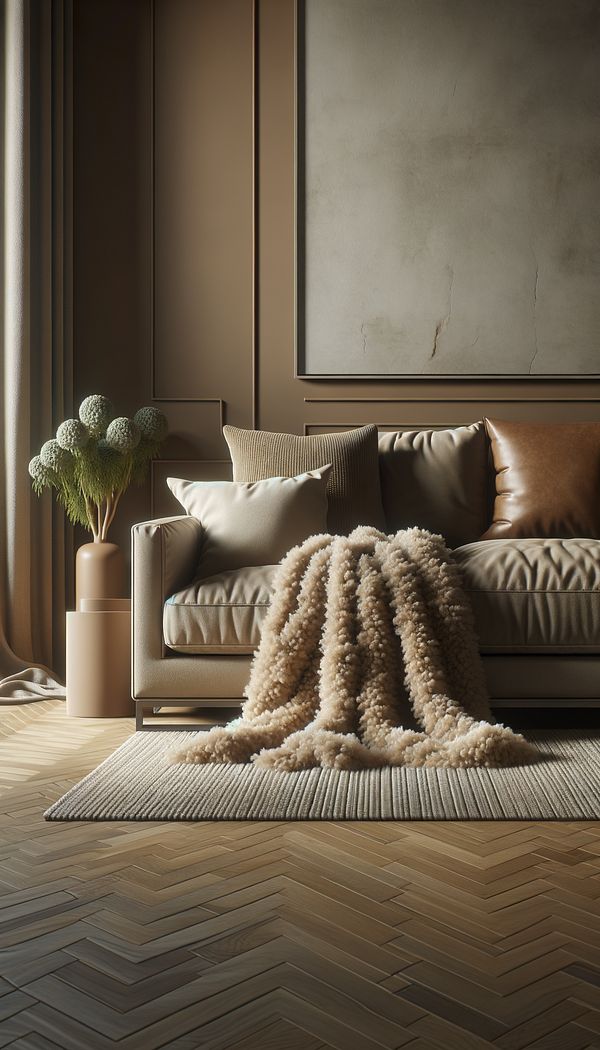What is Camel Hair?
Camel hair refers to the soft, downy undercoat or underlayer that camels shed naturally, which is harvested and used in textiles.
Description
In the realm of interior design, camel hair is prized for its exceptional warmth, softness, and durability. This natural fiber is collected from the undercoats of camels, primarily from the Bactrian species, which have two humps. Unlike the coarse outer hair, the undercoat is extremely soft and fine, making it ideal for luxurious textiles. Camel hair's natural color ranges from light tan to a deep, earthy brown, adding a warm and natural aesthetic to any interior space.
Camel hair textiles are notably versatile and can be woven into a variety of fabrics, including wool for throws, blankets, and even upholstery. The unique properties of camel hair, such as its excellent insulation and breathability, make it a prized material for items intended to provide warmth without the weight of more traditional materials. Additionally, its natural oils provide a degree of water resistance and durability that is difficult to match.
Incorporating camel hair into interior design projects can add an element of luxury and comfort, while also introducing a tactile element that encourages interaction. Its natural hues and textures can complement design styles that emphasize earth tones and materials, such as rustic, minimalist, or Scandinavian themes. Camel hair's sustainability as a renewable resource further aligns with contemporary trends towards eco-friendly and sustainable design philosophies.
Usage
Camel hair is often used in interior design through high-quality home textiles such as throws, blankets, and sometimes in the upholstery of furniture. It is especially favored in designs that seek to combine luxury with functionality, providing warmth and comfort while adding a touch of elegance to the décor. Additionally, smaller decorative items like pillows or even wall textiles may utilize camel hair to bring texture and a sense of natural beauty into the home.
FAQs
-
Is camel hair ethical?
Yes, camel hair is generally considered ethical as it is harvested through combing or collecting the fibers camels naturally shed, without harming the animal. It is a sustainable and renewable resource.
-
Can camel hair items be washed?
Camel hair textiles should be handled with care. While some items may be gently hand-washed in cold water, it's generally recommended to dry-clean camel hair products to preserve their texture and quality.
-
How does camel hair compare to other natural fibers like wool or cashmere?
Camel hair shares similar qualities with wool and cashhair, offering excellent insulation and softness. However, it tends to be more breathable and provides better moisture-wicking properties than wool, and can be more durable and less expensive than cashmere, making it a unique alternative.
Practical Application
When incorporating camel hair textiles into your interior design, consider their natural color and texture to enhance the overall aesthetic of the space. Camel hair blankets or throws can add warmth and luxury to a living room or bedroom, elevating the comfort level. To preserve the quality of camel hair products, follow care instructions carefully, generally opting for professional cleaning services. Its versatility also makes camel hair a great choice for adding texture and a touch of nature to your design, especially in spaces that embrace natural materials and hues.
-
Design Styles478 articles
-
Decorating Principles & Elements330 articles
-
Materials & Textiles360 articles
-
Textiles & Upholstery252 articles
-
Sustainability & Eco-Friendly Design69 articles
-
LayeredLayered refers to the technique of adding multiple elements to create depth and interest in an interior design.
-
GinghamGingham is a medium-weight, balanced plain-woven fabric made from dyed cotton or cotton-blend yarn.
-
End MatchingEnd matching refers to a technique used in the installation of wood flooring and paneling.
-
MatchboardingMatchboarding is a method of paneling walls and ceilings using long, narrow planks of wood.
-
LoftA loft is a large, adaptable open space, often a former industrial building or other type of space converted for residential use.
